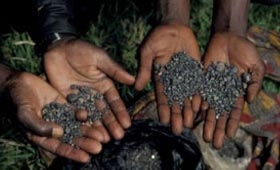Venezuela’s abundant coltan resources are exploited by several armed groups, and Colombian rebels the FARC may be the best positioned to become major players in extracting the new “conflict mineral.”
Columbite-tantalite, or coltan, is a metallic ore used in electronic devices, from smart phones and optical fibers to atomic stations and missiles, and is notorious for being sourced from conflict zones in central Africa. However, according to a recent report by the International Consortium of Investigative Journalists (ICIJ), in conjunction with iWatch News, coltan may potentially emerge as a “conflict mineral” in Venezuela.
The majority of Venezuela’s apparently vast coltan reserves — the existence of which was announced triumphantly in 2009 by President Hugo Chavez, who later claimed the reserves could be worth $100 billion — lies along the border with Colombia in the Venezuelan states of Amazonas and Bolivar. Though Chavez immediately outlawed mining of the mineral, sending 15,000 military personnel there as part of “Operation Blue Gold” to crack down on illegal prospectors smuggling coltan into Colombia (where there is a legal market), violence has been on the rise in the cross-border region thanks to the presence of both·paramilitaries·and guerrillas, state the ICIJ authors.
Because coltan mining is illegal in Venezuela, this has created a “regulatory vacuum” which has allowed armed groups to step in and control the black market trade, the ICIJ notes. One of these is likely to be the Revolutionary Armed Forces of Colombia (FARC), a group with a history of illegal mining operations and a presence in Venezuela.
A source told InSight Crime that the FARC’s 16th Front, based in Colombia’s eastern departments of Guainia and Vichada, are extorting miners on the Venezuelan side of the border. Much of this extortion is related to Venezuela’s gold mining industry, although the rebel group are believed to be expanding their operations into coltan. According to the source, the guerrillas, who feel a comparative degree of safety on the Venezuelan side, have set up “bodegas,” or storage points, for cocaine, and encampments for rest and recuperation. These areas of refuge are similar to the FARC camps found in northern Ecuador.
Mining has become a crucial source of finances for the FARC over the last decade. Although not on a par with the income generated by the group’s drug trafficking, illegal mining has overtaken kidnapping in terms of economic importance.
As InSight Crime mapped out last year, the FARC are alleged to control unlicensed mines throughout Colombia. The majority are gold mines where the rebels extort machinery, charging a tax for each backhoe which enters their territory, as well as monthly “maintenance” tax per machine. The guerrillas destroy the equipment if payments are not made on time.
Entrance fees in some areas can run as high as $1,600 per backhoe, providing significant profits for the FARC, with some estimates putting their monthly income from illegal mining at just under $1 million.
According to another ICIJ article (see video report, below), the FARC and other armed groups have diversified from gold mines and moved into coltan operations in both Guainia and Vichada. The guerrillas typically have control over the mining site, paramilitaries control the trafficking route into Guiania, and drug traffickers transport the mineral out of the area, one miner told the ICIJ. A 2009 report by Colombian magazine Semana stated that the “tax” charged by criminals in some of these areas can reach up to $2,500 per ton extracted.
Although the FARC’s illegal mining operations in Colombia are extensive, the Colombian government has at least begun to take measures to prevent it. In 2010, the government instigated a nation-wide campaign against illegal mining, which President Juan Manuel Santos described as a “cancer we must remove.” Police have said that in 2011, they shut down 275 gold mines and arrested 1,228 people.
In contrast, Venezuelan authorities have moved much more slowly against unlicensed mining. While Chavez launched Plan Cauca in April 2010, an initiative aimed at clamping down on the environmental destruction caused by illegal gold mining in the country, and one that has seen some success to date, the government has been noticeably quieter with regards to coltan mining aside from the apparently futile Operation Blue Gold.
As a researcher for Germany’s Wuppertal Institute for Climate, Environment and Energy told the ICIJ, Chavez’s failure to address the rising black market demand for coltan could lead to an increasingly unmanageable market and heightened levels of violence associated with the industry.
There a few factors which could open the door for increased FARC involvement in the coltan trade. The first is the alleged closeness of elements of the Chavez administration with·the guerrillas.·Members of Chavez’s cabinet, particularly the recently appointed defense minister, General Henry Rangel, have been accused of actively colluding with the FARC.·As InSight Crime has argued, the Chavez administration may have a strategic interest in allowing the FARC to use Venezuela as a refuge, if they can use the guerrillas as a bulwark against Colombia.·This could mean that even if measures are taken against coltan mining, the FARC could be afforded a degree of freedom in their Venezuela-based mines.
Secondly, with Chavez’s health status shrouded in uncertainty, following his second operation for a malignant growth in his pelvis, illegal mining is likely to be pushed far down the list of priorities for the Venezuelan government. Even if he fails to win this year’s presidential elections, his successor must address a·number of other security issues·that would hold primacy over illegal mining.
The FARC are not, and by no means will be, the only armed group exploiting Venezuela’s non-existent regulatory system for the coltan industry. However, considering their extensive experience in mining operations in Colombia, and their historic presence and comparative freedom across the border, they are poised to move to the fore in mining the “conflict mineral.”

